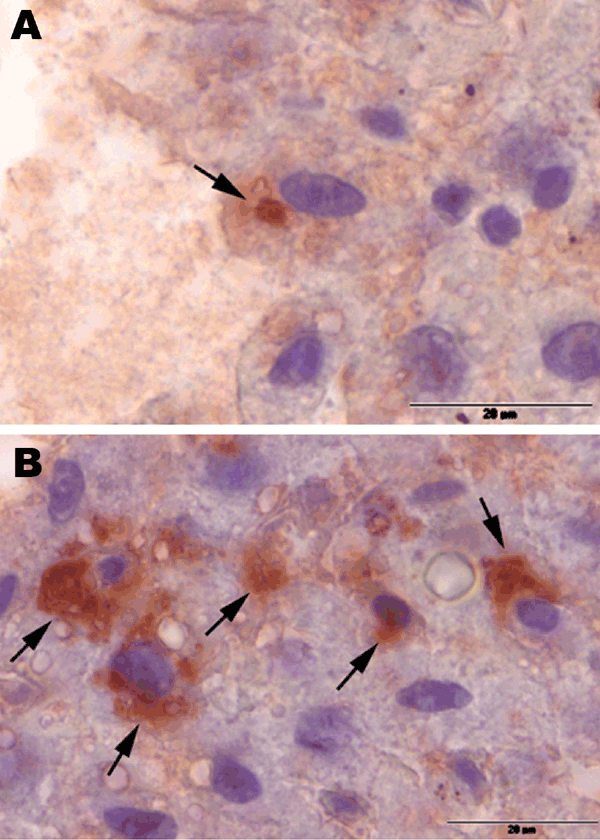Volume 16, Number 9—September 2010
Dispatch
Novel Hepatitis E Virus Genotype in Norway Rats, Germany
Figure 2

Figure 2. Immunohistochemical staining (peroxidase-antiperoxidase (PAP) technique) of liver samples from 2 rat-hepatitis E virus (HEV)–positive Norway rats from Germany, July 2009. Arrows indicate immunohistochemical positive reactions in the cytoplasm of single hepatocytes (A) and in a few foci in hepatocytes and stellate cells (B). For PAP staining, deparaffinized slides of liver samples were incubated with anti-HEV–positive human serum, which had been previously used to detect rat HEV by using solid phase immunoelectron microscopy (10), for 1 h at 37°C with protein A (Sigma-Aldrich, Steinheim, Germany) at a dilution of 1:100 for 45 min at 37°C and finally with PAP complexes from rabbits (Sigma, St. Louis, MO, USA) at a dilution 1:200 for 45 min at 37°C. AEC (3-amino-9-ethylcarbazol; Sigma Chemie GmbH, Deisenhofen, Germany) was used as the substrate chromogene. The slides were counterstained with hematoxylin and subsequently analyzed by light microscopy. Scale bars = 20 µm.
References
- Meng XJ. Hepatitis E virus: animal reservoirs and zoonotic risk. Vet Microbiol. 2009;140:256–65. DOIPubMedGoogle Scholar
- Teshale EH, Howard CM, Grytdal SP, Handzel TR, Barry V, Kamili S, Hepatitis E epidemic, Uganda. Emerg Infect Dis. 2010;16:126–9. DOIPubMedGoogle Scholar
- Lewis HC, Wichmann O, Duizer E. Transmission routes and risk factors for autochthonous hepatitis E virus infection in Europe: a systematic review. Epidemiol Infect. 2010;138:145–66. DOIPubMedGoogle Scholar
- Schielke A, Sachs K, Lierz M, Appel B, Jansen A, Johne R. Detection of hepatitis E virus in wild boars of rural and urban regions in Germany and whole genome characterization of an endemic strain. Virol J. 2009;6:58. DOIPubMedGoogle Scholar
- Kabrane-Lazizi Y, Fine JB, Elm J, Glass GE, Higa H, Diwan A, Evidence for widespread infection of wild rats with hepatitis E virus in the United States. Am J Trop Med Hyg. 1999;61:331–5. PubMedGoogle Scholar
- Favorov MO, Kosoy MY, Tsarev SA, Childs JE, Margolis HS. Prevalence of antibody to hepatitis E virus among rodents in the United States. J Infect Dis. 2000;181:449–55. DOIPubMedGoogle Scholar
- Arankalle VA, Joshi MV, Kulkarni AM, Gandhe SS, Chobe LP, Rautmare SS, Prevalence of anti–hepatitis E virus antibodies in different Indian animal species. J Viral Hepat. 2001;8:223–7. DOIPubMedGoogle Scholar
- Easterbrook JD, Kaplan JB, Vanasco NB, Reeves WK, Purcell RH, Kosoy MY, A survey of zoonotic pathogens carried by Norway rats in Baltimore, Maryland, USA. Epidemiol Infect. 2007;15:1–8.PubMedGoogle Scholar
- Ulrich RG, Schmidt-Chanasit J, Schlegel M, Jacob J, Pelz H-J, Mertens M, Network “Rodent-borne pathogens“ in Germany: longitudinal studies on the geographical distribution and prevalence of hantavirus infections. Parasitol Res. 2008;103(Suppl. 1):S121–9. DOIPubMedGoogle Scholar
- Johne R, Plenge-Bönig A, Hess M, Ulrich RG, Reetz J, Schielke A. Detection of a novel hepatitis E–like virus in feces of wild rats using a nested broad-spectrum RT-PCR. J Gen Virol. 2010;91:750–8. DOIPubMedGoogle Scholar
- Koonin EV, Gorbalenya AE, Purdy MA, Rozanov MN, Reyes GR, Bradley DW. Computer-assisted assignment of functional domains in the nonstructural polyprotein of hepatitis E virus: delineation of an additional group of positive-strand RNA plant and animal viruses. Proc Natl Acad Sci U S A. 1992;89:8259–63. Medline DOIPubMedGoogle Scholar
- Braaker S, Heckel G. Transalpine colonisation and partial phylogeographic erosion by dispersal in the common vole Microtus arvalis. Mol Ecol. 2009;18:2518–31. DOIPubMedGoogle Scholar
- Zhao C, Ma Z, Harrison TJ, Feng R, Zhang C, Qiao Z, A novel genotype of hepatitis E virus prevalent among farmed rabbits in China. J Med Virol. 2009;81:1371–9. DOIPubMedGoogle Scholar
- Emerson SU, Anderson D, Arankalle A, Meng X-J, Purdy M, Schlauder GG, Hepevirus. In: CM Fauquet, MA Mayo, J Maniloff, U Desselberger, LA Ball, editors. Virus taxonomy. San Diego: Elsevier Academic Press; 2005. p. 853–7.
- Lee YH, Ha Y, Ahn KK, Chae C. Localisation of swine hepatitis E virus in experimentally infected pigs. Vet J. 2009;179:417–21. DOIPubMedGoogle Scholar